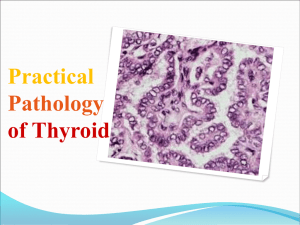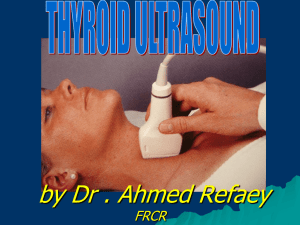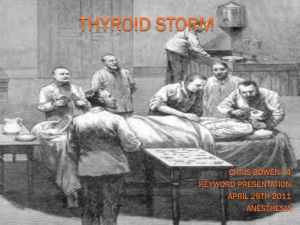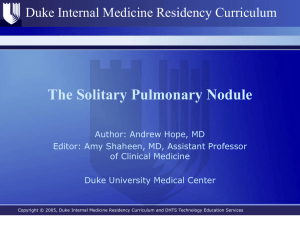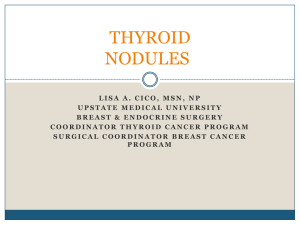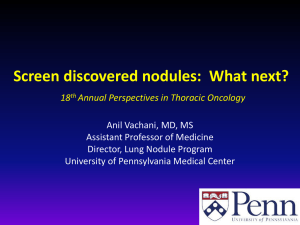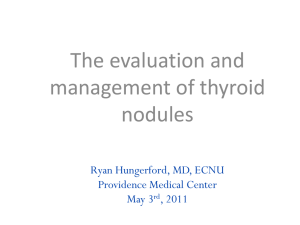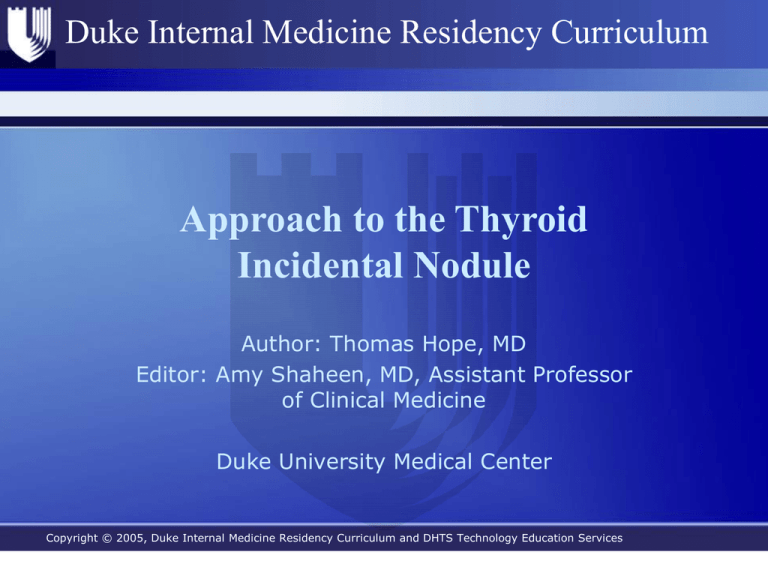
Duke Internal Medicine Residency Curriculum
Approach to the Thyroid
Incidental Nodule
Author: Thomas Hope, MD
Editor: Amy Shaheen, MD, Assistant Professor
of Clinical Medicine
Duke University Medical Center
Copyright © 2005, Duke Internal Medicine Residency Curriculum and DHTS Technology Education Services
Duke Internal Medicine Residency Curriculum
Thyroid Nodules: Incidence
• Definition:
– A lesion incidentally discovered radiographically
measuring >1cm.
• Incidence:
– 4-7% of all adult patients have a palpable thyroid
nodule
– 1 in 20 of these nodules is cancerous
Copyright © 2005, Duke Internal Medicine Residency Curriculum and DHTS Technology Education Services
Duke Internal Medicine Residency Curriculum
Thyroid Nodules: Differential Diagnosis (UTDOL)
• Benign
– Multinodular goiter
– Hashimoto’s thyroiditis
– Cysts—colloid, simple,
hemorrhagic
– Follicular adenomas
– Hurthle cell adenomas
Most common diagnoses: colloid
nodules, cysts, and thyroiditis (80%),
benign follicular neoplasms (10-15%),
thyroid CA (5%) (Hegedus, NEJM
2004)
• Malignant
– Papillary carcinoma
– Follicular CA—minimally or
widely invasive, Hurthlecell type
– Medullary carcinoma
– Anaplastic carcinoma
– Primary thyroid lymphoma
– Metastatic carcinoma—
breast, renal,etc
Copyright © 2005, Duke Internal Medicine Residency Curriculum and DHTS Technology Education Services
Duke Internal Medicine Residency Curriculum
Thyroid Nodules: Risk factors for malignancy
• High suspicion: Family hx of medullary thyroid CA or
MEN, rapid tumor growth, very firm/hard nodule,
fixation of nodule to adjacent structures, paralysis of
vocal cords, regional lymphadenopathy, distant
metastases
• Moderate suspicion: Age <20 or >70, male sex, hx
head/neck irradiation, nodule >4cm or partially cystic,
symptoms of compression—dysphagia, hoarseness,
dysphonia
• If two or more high suspicion risk factors present,
cancer is the diagnosis nearly 100% of time.
Copyright © 2005, Duke Internal Medicine Residency Curriculum and DHTS Technology Education Services
Duke Internal Medicine Residency Curriculum
Thyroid Nodules: General approach to incidental palpable thyroid nodule
• Step 1: Check TSH.
– If TSH is low the likelihood is for a benign “hot nodule”.
The next step is a thyroid radionuclide uptake scan. If “hot
nodule” is present, initiate appropriate therapy if needed,
without need for biopsy.
– If TSH is high check anti-thyroperoxidase antibodies to try
to rule in Hashimoto’s thyroiditis. Even if positive, however, a
coexisting cancer could be present, making FNA necessary
anyway (proceed to step 2).
– If TSH is normal proceed to step 2.
– If there is a family history of medullary thyroid cancer or MEN2 a serum calcitonin should be checked (will be high in
medullary thyroid CA). Then proceed to step 2.
Copyright © 2005, Duke Internal Medicine Residency Curriculum and DHTS Technology Education Services
Duke Internal Medicine Residency Curriculum
Thyroid Nodules: General approach to incidental palpable thyroid nodule (2)
• Step 2: FNA-- with ultrasound guidance.
Notice that a plain thyroid ultrasound is
not the recommended next step—it does
not obviate the need for a FNA. FNA can
distinguish benign nodules, papillary
carcinoma, or follicular neoplasm, but not
between follicular adenoma and follicular
carcinoma.
Copyright © 2005, Duke Internal Medicine Residency Curriculum and DHTS Technology Education Services
Duke Internal Medicine Residency Curriculum
Thyroid Nodules: General approach to incidental palpable thyroid nodule (3)
• Step 3: Surgery (for suspicious or malignant nodules on FNA-including follicular neoplasm) or follow up (confirmed benign
nodule on FNA). Alternative treatments for a benign nodule
include levothyroxine therapy, surgery, ethanol injections—any of
these should be guided by an endocrinologist, i.e. Dr. Warner
Burch, Duke’s thyroid expert.
• NOTE: According to expert opinion (er…UTDOL), a thyroid nodule
<1 cm found incidentally on an unrelated imaging study (i.e.
carotid Doppler ultrasound) enters a realm of controversy.
Studies are cited for and against FNA, with no clear
recommendation. The 1996 AACE guidelines (have times changed
since then?) recommend conservative follow up (i.e. serial
physical exams) unless risk factors or suspicious nodule
characteristics are present. A nodule >1cm should follow the
guidelines for the palpable nodule.
Copyright © 2005, Duke Internal Medicine Residency Curriculum and DHTS Technology Education Services
Duke Internal Medicine Residency Curriculum
Thyroid Nodules: Algorithm for incidental palpable thyroid nodule
Click here to view
a .pdf file of this
algorithm
Note: This algorithm is included
as an attachment from this
presentation as well as a
module listing in the course
outline
Copyright © 2005, Duke Internal Medicine Residency Curriculum and DHTS Technology Education Services
Duke Internal Medicine Residency Curriculum
Thyroid Nodules: Question (1)
A 42-year-old woman presents with a
palpable mass on the left side of her neck.
She has no neck pain and no symptoms of
thyroid dysfunction. Physical examination
reveals a solitary, mobile thyroid nodule, 2 cm
by 3 cm, without lymphadenopathy. The
patient has no family history of thyroid
disease and no history of external irradiation.
Copyright © 2005, Duke Internal Medicine Residency Curriculum and DHTS Technology Education Services
Duke Internal Medicine Residency Curriculum
Thyroid Nodules: Correct Answer rationale (1)
A) All patients with a thyroid nodule should have a TSH checked,
followed by either an FNA if the result is normal or high, or a
radionuclide scan if low. A thyroid ultrasound does not avoid the
need for a FNA, so it should not be ordered without a plan for
simultaneous biopsy. Tissue is preferred prior to surgery (even for
high risk patients, where the pathology may guide surgical
approach). A serum calcitonin level would be important to order
with the TSH if the patient had a family history of medullary
thyroid cancer or MEN-2. (source: Hegedus, NEJM 2004)
Copyright © 2005, Duke Internal Medicine Residency Curriculum and DHTS Technology Education Services
Duke Internal Medicine Residency Curriculum
Thyroid Nodules: Question (2)
A 37 y/o asymptomatic woman presents for a
routine physical examination. Physical
examination reveals a 2-cm right-sided
thyroid nodule that is firm, non-tender and
moves with swallowing. The rest of the
physical exam is unremarkable, including
normal reflexes and absence of tremor. The
TSH level is 1.8. She is referred for fineneedle aspiration biopsy of the thyroid
nodule.
Copyright © 2005, Duke Internal Medicine Residency Curriculum and DHTS Technology Education Services
Duke Internal Medicine Residency Curriculum
Thyroid Nodules: Correct Answer rationale (2)
D) When adequate samples are obtained from FNA (less
likely with cystic lesions), approximately 85% of nodules
are benign adenomatoid, cellular, or cystic. A certain
proportion can be characterized as papillary cancers.
However, FNA biopsy cannot distinguish between
malignant and benign follicular neoplasms because these
entities are cytologically identical. Thus, in many cases,
patients with papillary carcinoma or follicular neoplasm
on FNA biopsy are referred for surgery (source: MKSAP13)
Copyright © 2005, Duke Internal Medicine Residency Curriculum and DHTS Technology Education Services
Duke Internal Medicine Residency Curriculum
Thyroid Nodules: Sources
• Hegedus L, Clinical Practice: The Thyroid Nodule, NEJM 2004,
351(17):1764-1771
• AACE Clinical Guidelines for the Diagnosis and Management of
Thyroid Nodules, AACE Thyroid Nodule Task Force, 1996.
• Up to Date, 2005.
Copyright © 2005, Duke Internal Medicine Residency Curriculum and DHTS Technology Education Services


